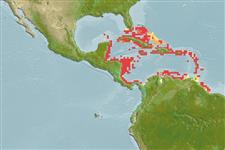Common names from other countries
Classification / Names / Names
Common names | Synonyms | Catalog of Fishes (gen., sp.) | ITIS | CoL | WoRMS
Environment: milieu / climate zone / depth range / distribution range
Ecology
Benthic; depth range 0 - 7 m (Ref. 83435). Tropical; 26°N - 6°N, 89°W - 57°W
Western Central Atlantic.
Length at first maturity / Size / Weight / Age
Maturity: Lm ?, range 1 - 3.4 cm Max length : 18.0 cm SHW male/unsexed; (Ref. 105349); common length : 10.0 cm TL male/unsexed; (Ref. 355)
Shell large, heavy, conical, with rounded shoulders. Umbilicus deep and round, operculum multispiral, circular. Colour: purple-black on a whitish background; aperture white, internally nacreous; operculum iridescent brown.
Stocks have been locally extirpated or are diminishing due to over exploitation (Ref. 355).
Broadcast spawners. Spawning occurs during lunar period. Females lay eggs in ribbons or jelly masses in the substratum, after the males have released their sperm (Ref. 105346). Males don't have penis (Ref. 105349). Life cycle: Embryos develop into planktonic trocophore larvae and later into juvenile veligers before becoming fully grown adults (Ref. 833).
Leal, J.H. 2003. (Ref. 355)
IUCN Red List Status (Ref. 130435: Version 2024-1)
CITES status (Ref. 108899)
Not Evaluated
Not Evaluated
Human uses
Fisheries: commercial
| FishSource | Sea Around Us
Tools
Internet sources
Estimates based on models
Preferred temperature
(Ref.
115969): 26.8 - 28.2, mean 27.7 (based on 344 cells).
Resilience
Medium, minimum population doubling time 1.4 - 4.4 years (K=0.19-0.2).
Vulnerability
Low to moderate vulnerability (31 of 100).
Price category
Unknown.
